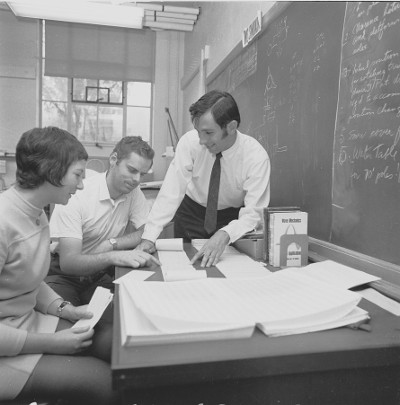 Bill Dent (right) with students (Photo courtesy of University of Massachusetts Archives
Bill Dent (right) with students (Photo courtesy of University of Massachusetts Archives
William A. Dent
Contributed by William Irvine
William A. (Bill) Dent was born on July 13, 1938, and died March 18, 2020.
Dent was a key founder of the observational aspect of the Astronomy Program at UMass Amherst. As a graduate student at the University of Michigan, Bill had found that the radio brightness of quasars varied with time. This required that the physical sizes of these objects be vastly smaller than had been postulated; many years later we have learned that quasars contain supermassive black holes, often with masses of billions of times the mass of our Sun.
The new Astronomy Program at UMass had begun in 1966 with the hiring of three theoretical
astrophysicists. Clearly an astronomy program needed an observational component, and just as clearly New England was not a good location for traditional optical astronomy. Radio astronomy, where at most wavelengths the atmosphere is relatively transparent, was a possibility, if suitable faculty could be recruited.
When Bill joined the new Astronomy Program at the University of Massachusetts, he took advantage of the University being a charter member of the Northeast Radio Observatory Corporation (NEROC). After its original goal of building a new, extremely large radio telescope was not successful, NEROC took over from the Air Force the operation of the 37-meter-diameter Haystack radio telescope in Westford, MA. In addition to the Haystack Observatory, Bill also utilized the National Radio Astronomy Observatory's 36-foot telescope at Kitt Peak, the now-defunct 300-ft NRAO telescope at Green Bank, and the FCRAO millimeter radio telescope in his frontline studies of the variations in brightness of quasars, now commonly known as Active Galactic Nuclei (AGN). He continued to publish significant research results in the major astronomical journals throughout his career, normally with funding from federal science agencies. Bill was a member of the International Astronomical Union and was active in three of its Divisions.
As a professor at UMass, Bill trained graduate students who have gone on, for example, to tenured faculty positions at American and Canadian universities and to important positions at the US National Science Foundation and the Space Telescope Science Institute. He was a great motivator of the graduate students, helping them relax via local swing dancing and once taking several canoeing through the Minnesota Boundary Waters. Bill was the chair of the committee for the student who was UMass's first Black astronomy PhD recipient.
Bill's colleagues also recall his trips to very exotic places and the very adventurous ways he traveled, including bus trips in Bolivia, a trek across northern Australia by all-terrain truck,
hiking the Tonto Plateau of the Grand Canyon and a far-off-the-beaten-track portion of Canyonlands National Park in mid-summer, and a month-long trek to the Mount Everest region of Nepal.
![[IAU logo]](iau_wb_thumb.jpg)
![[URSI logo]](URSI-logo-thumb.jpg)
![[Karl Jansky at his antenna]](jansky_photo_02_thumb.jpg)
![[Reber's Wheaton antenna]](Reber_Telescope_Wheaton_thumb.jpg)
![[Dover Heights]](Dover_Heights_02_thumb.jpg)
![[4C telescope]](GB61-195_4C_telescope_thumb.jpg)
![[Ewen and horn antenna]](ewen_horn1s.jpg)
![[Dwingeloo, 1956]](Dwingeloo-1956-thumb.jpg)
![[Jocelyn Bell Burnell and Cambridge antenna used in pulsar discovery]](burnell2_thumb.jpg)
![[Lovell Telescope at Jodrell Bank]](site_1594_0001-500-334-20180316163019-thumb150.jpg)
![[Wilson, Penzias, and Bell Labs horn antenna]](wilson-penzias-horn_thumb.jpg)
![[6-m Millimeter Radio Telescope in Mitaka, Japan]](6m-thumb.jpg)

